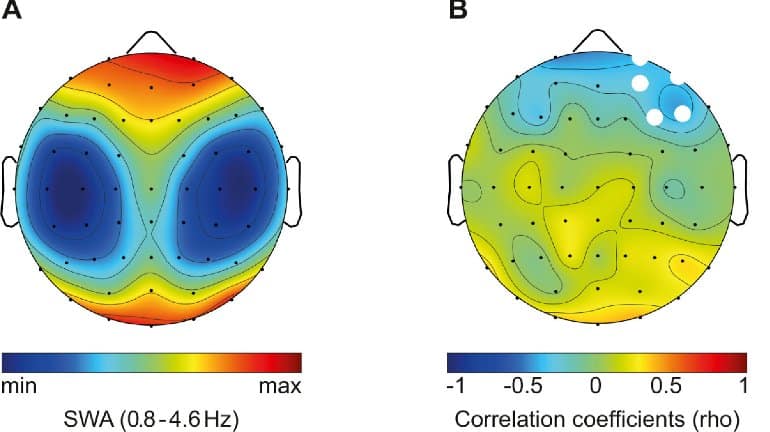Summary: The fewer slow brain waves that occur in the right prefrontal cortex during sleep, the more likely a person is to indulge in risk-taking behaviors.
Source: University of Bern
Each person has their own individual sleep profile which can be identified by the electrical brain activity during sleep.
Researchers at the University of Bern have now demonstrated that the brain waves during periods of deep sleep in a specific area of the brain can be used to determine the extent of an individual’s propensity for risk during their everyday life.
Each day, we make countless decisions in which we take different risks—in road traffic, when buying shares or in our sexual behavior, for example. The propensity for risk varies from one individual to the next.
Researchers led by Daria Knoch, Professor of Social Neuroscience at the University of Bern, have demonstrated that clues in the brain concerning an individual’s propensity for risk can be gathered as they sleep:
“The fewer slow waves an individual has over their right prefrontal cortex during deep sleep, the greater their propensity for risk. Among other functions, this region of the brain is important to control one’s own impulses,” explains the neuroscientist.
The results have recently been published in the journal NeuroImage.
High data density and sleep investigation at participant’s home
Slow waves occur during deep sleep and indicate good sleep quality and regeneration. The topographical distribution of slow waves in the brain is highly individual and is highly stable over time; this means each individual has their own personal neuronal sleep profile.
To determine whether this profile reveals anything about an individual’s propensity for risk, the research team studied 54 “good sleepers,” who typically sleep for seven to eight hours.
These were identified using actigraphs, which track the patterns of movement during sleep. Because: “The individual slow-wave profile can only be interpreted correctly during normal sleep,” explains leader of the study, Lorena Gianotti.
In the next step, sleep data was collected at participants’ home using a portable polysomnographic system with 64 electrodes placed at their scalp.
“The undisturbed measurement of the brain activity during sleep in a familiar environment and the high density of data collected by the 64 electrodes are rather rare as a constellation in sleep research. This allows the participants to sleep naturally and allows us to collect a large quantity of data,” explains doctoral student and first author, Mirjam Studler.
Less deep sleep in the right prefrontal cortex
And this data is very meaningful and significant: participants who show lower slow-wave activity over their right prefrontal cortex generally demonstrate a greater propensity for risk than individuals with more slow-wave activity.

The propensity to take risks was elicited in a computer game where they could win actual money: the participants had to decide how far they would drive a car in the knowledge that at some point, a wall would appear with which the car would collide. Each meter driven earned them more money, but also increased their risk of crashing.
“Interestingly, the sleep duration had no impact in terms of propensity for risk, at least in our study with good sleepers. Rather, it is crucial that deep sleep takes place in the ‘right’ brain regions—in this case, in the right prefrontal cortex,” explains Lorena Gianotti.
Possible implications
Health economics research has demonstrated that risky behavior can have both considerable health-related and financial consequences. According to the researchers, gaining a better understanding of the mechanisms underlying the propensity for risky behavior is therefore important. “Our findings can be incorporated into targeted interventions. Sleep researchers are now developing techniques to specifically modulate slow waves,” says Daria Knoch.
About this sleep and behavioral research news
Author: Press Office
Source: University of Bern
Contact: Press Office – University of Bern
Image: The image is credited to the researchers
Original Research: Open access.
“Local slow-wave activity over the right prefrontal cortex reveals individual risk preferences” by Mirjam Studler et al. NeuroImage
Abstract
Local slow-wave activity over the right prefrontal cortex reveals individual risk preferences
In everyday life, we have to make decisions under varying degrees of risk. Even though previous research has shown that the manipulation of sleep affects risky decision-making, it remains unknown whether individual, temporally stable neural sleep characteristics relate to individual differences in risk preferences.
Here, we collected sleep data under normal conditions in fifty-four healthy adults using a portable high-density EEG at participants’ home. Whole-brain corrected for multiple testing, we found that lower slow-wave activity (SWA, an indicator of sleep depth) in a cluster of electrodes over the right prefrontal cortex (PFC) is associated with higher individual risk propensity.
Importantly, the association between local sleep depth and risk preferences remained significant when controlling for total sleep time and for time spent in deep sleep, i.e., sleep stages N2 and N3. Moreover, the association between risk preferences and SWA over the right PFC was very similar in all sleep cycles.
Because the right PFC plays a central role in cognitive control functions, we speculate that local sleep depth in this area, as reflected by SWA, might serve as a dispositional indicator of self-regulatory ability, which in turn reflects risk preferences.






